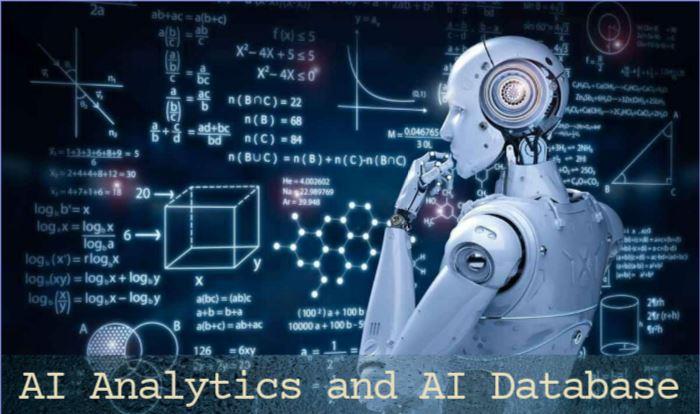AI Analytics
AI Database Design
Welcome to the intriguing universe of artificial intelligence (AI), where database and AI form a dynamic duo, revolutionizing analytical applications. Let’s delve into how AI intelligence and the best database for artificial intelligence work in tandem to redefine intelligent analytics.
Table of Contents
ToggleAI Intelligence: A Fresh Outlook
AI is reshaping our comprehension and utilization of data. AI intelligence is akin to possessing a superpower that can identify patterns in transactional data. But it doesn’t stop there. AI intelligence amalgamates data from diverse sources such as social media and historical records. This holistic perspective empowers AI intelligence to forecast consumer behavior and recommend pertinent products.
The Four Cornerstones of Intelligent Database
Intelligent database can be encapsulated in four terms: Sense, Learn, Decide, and Act. The ‘Sense’ phase involves gathering data from various sources. The ‘Learn’ phase is where the system comprehends contextual information. The ‘Decide’ phase is where multiple alternatives are assessed. Finally, the ‘Act’ phase involves implementing decisions.
AI Art Database: The Silent Warrior
An AI art database offers essential storage and processing capabilities for seamless data management. An AI art database swiftly ingests, explores, analyzes, and visualizes intricate data streams within milliseconds. The ultimate goal is not just cost reduction and revenue generation but also the smooth integration of Machine Learning (ML) models.

Selecting Your AI Database: RDBMS or NoSQL?
Traditional relational databases (RDBMS) often fail to meet the demands of AI. Enter NoSQL databases! These non-relational databases have emerged as game-changers in the realm of AI and deep learning. They efficiently manage both structured and unstructured data, scale effortlessly with cost-effective hardware additions, and their default replication model ensures high availability.
Why NoSQL Excels in AI?
NoSQL databases offer several benefits:
Flexible Data Model: NoSQL adapts to evolving data structures during the ‘Learn’ phase. On-Demand Scalability: NoSQL can manage large datasets and seamlessly integrates additional resources. Fault Tolerance: Default replication models ensure high fault tolerance. Consistency and Integration: NoSQL maintains seamless consistency and integrates effortlessly through custom APIs. Enhancing AI Performance with Data Caching
Optimizing AI performance extends beyond just processing power; it also involves caching learning data to accelerate iterative computations. Various options such as distributed caches (like Memcached, Redis), data grids (Hazelcast, GigaSpaces), and computing platforms (Apache Ignite, Oracle Exadata) can significantly boost efficiency.

FAQ.
What is AI Analytics?
AI Analytics is a transformative approach to data understanding and usage. It can spot patterns in transactional data and merges data from various sources like social media and historical records. This comprehensive view enables AI Analytics to predict consumer behavior and suggest relevant products.
What are the four pillars of Intelligent Analytics?
The four pillars of Intelligent Analytics are Sense, Learn, Decide, and Act. The ‘Sense’ phase involves collecting data from various sources. The ‘Learn’ phase is where the system understands contextual information. The ‘Decide’ phase is where multiple options are evaluated. Finally, the ‘Act’ phase involves executing decisions.
What role does an AI Database play?
An AI Database provides crucial storage and processing capabilities for smooth data management. It quickly ingests, explores, analyzes, and visualizes complex data streams within milliseconds. The ultimate aim is not just cost reduction and revenue generation but also seamless integration of Machine Learning (ML) models.
Why might one choose a NoSQL database over a traditional RDBMS for AI applications?
Traditional relational databases (RDBMS) often fall short when it comes to meeting the demands of AI. NoSQL databases efficiently handle both structured and unstructured data, scale easily with cost-effective hardware additions, and their default replication model ensures high availability.
What advantages do NoSQL databases bring to AI?
NoSQL databases offer a flexible data model that adapts to changing data structures during the ‘Learn’ phase, on-demand scalability for handling large datasets, high fault tolerance through default replication models, and seamless consistency and integration through custom APIs.
How can AI performance be boosted with Data Caching?
Optimizing AI performance extends beyond just processing power; it also involves caching learning data to speed up iterative computations. Various options such as distributed caches (like Memcached, Redis), data grids (Hazelcast, GigaSpaces), and computing platforms (Apache Ignite, Oracle Exadata) can significantly enhance efficiency.
what is AI Database?
An AI Database provides crucial storage and processing capabilities for smooth data management. It quickly ingests, explores, analyzes, and visualizes complex data streams within milliseconds. The ultimate aim is not just cost reduction and revenue generation but also seamless integration of Machine Learning (ML) models. It’s a key component in the AI infrastructure, enabling efficient handling and processing of large volumes of data which is essential for AI applications.


Nice Article.